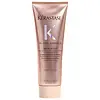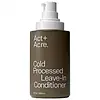What's inside
What's inside
 Key Ingredients
Key Ingredients

 Benefits
Benefits

 Concerns
Concerns

 Ingredients Side-by-side
Ingredients Side-by-side

Water
Skin ConditioningCetearyl Alcohol
EmollientCocamidopropyl Betaine
CleansingBehentrimonium Chloride
PreservativePropylene Glycol
HumectantAmodimethicone
Parfum
MaskingIsopropyl Alcohol
SolventSodium Chloride
MaskingPhenoxyethanol
PreservativeHydroxypropyl Guar
Emulsion StabilisingEthanolamine
BufferingPolyquaternium-37
Limonene
PerfumingCaprylyl Glycol
EmollientPropylene Glycol Dicaprylate/Dicaprate
EmollientCocos Nucifera Oil
MaskingTrideceth-6
EmulsifyingPPG-1 Trideceth-6
Skin ConditioningLinalool
PerfumingCitronellol
PerfumingCetrimonium Chloride
AntimicrobialAcrylates/Stearyl Methacrylate Copolymer
Emulsion StabilisingSorbitan Oleate
EmulsifyingSodium Hyaluronate
HumectantCaprylic/Capric Triglyceride
MaskingLactic Acid
BufferingHexyl Cinnamal
PerfumingAlpha-Isomethyl Ionone
PerfumingGlycolic Acid
BufferingCitric Acid
BufferingEDTA
Rosa Canina Flower Extract
AstringentWater, Cetearyl Alcohol, Cocamidopropyl Betaine, Behentrimonium Chloride, Propylene Glycol, Amodimethicone, Parfum, Isopropyl Alcohol, Sodium Chloride, Phenoxyethanol, Hydroxypropyl Guar, Ethanolamine, Polyquaternium-37, Limonene, Caprylyl Glycol, Propylene Glycol Dicaprylate/Dicaprate, Cocos Nucifera Oil, Trideceth-6, PPG-1 Trideceth-6, Linalool, Citronellol, Cetrimonium Chloride, Acrylates/Stearyl Methacrylate Copolymer, Sorbitan Oleate, Sodium Hyaluronate, Caprylic/Capric Triglyceride, Lactic Acid, Hexyl Cinnamal, Alpha-Isomethyl Ionone, Glycolic Acid, Citric Acid, EDTA, Rosa Canina Flower Extract
Water
Skin ConditioningSodium Phytate
Caprylhydroxamic Acid
1,2-Hexanediol
Skin ConditioningPropanediol
SolventGlycerin
HumectantGuar Hydroxypropyltrimonium Chloride
Skin ConditioningCitric Acid
BufferingHydrolyzed Vegetable Protein
Skin ConditioningSodium Acrylate/Sodium Acryloyldimethyl Taurate Copolymer
Emulsion StabilisingPolyisobutene
Caprylyl/Capryl Glucoside
CleansingEthylhexyl Olivate
Skin ConditioningSqualane
EmollientLimnanthes Alba Seed Oil
Skin ConditioningArgania Spinosa Kernel Oil
EmollientCrambe Abyssinica Seed Oil Phytosterol Esters
EmulsifyingTremella Fuciformis Sporocarp Extract
AntioxidantBetaine
HumectantGlyceryl Caprylate
EmollientGlyceryl Undecylenate
EmollientLauryl Glucoside
CleansingPolyglyceryl-2 Dipolyhydroxystearate
Skin ConditioningParfum
MaskingWater, Sodium Phytate, Caprylhydroxamic Acid, 1,2-Hexanediol, Propanediol, Glycerin, Guar Hydroxypropyltrimonium Chloride, Citric Acid, Hydrolyzed Vegetable Protein, Sodium Acrylate/Sodium Acryloyldimethyl Taurate Copolymer, Polyisobutene, Caprylyl/Capryl Glucoside, Ethylhexyl Olivate, Squalane, Limnanthes Alba Seed Oil, Argania Spinosa Kernel Oil, Crambe Abyssinica Seed Oil Phytosterol Esters, Tremella Fuciformis Sporocarp Extract, Betaine, Glyceryl Caprylate, Glyceryl Undecylenate, Lauryl Glucoside, Polyglyceryl-2 Dipolyhydroxystearate, Parfum
 Reviews
Reviews

Ingredients Explained
These ingredients are found in both products.
Ingredients higher up in an ingredient list are typically present in a larger amount.
Citric Acid is an alpha hydroxy acid (AHA) naturally found in citrus fruits like oranges, lemons, and limes.
Like other AHAs, citric acid can exfoliate skin by breaking down the bonds that hold dead skin cells together. This helps reveal smoother and brighter skin underneath.
However, this exfoliating effect only happens at high concentrations (20%) which can be hard to find in cosmetic products.
Due to this, citric acid is usually included in small amounts as a pH adjuster. This helps keep products slightly more acidic and compatible with skin's natural pH.
In skincare formulas, citric acid can:
While it can provide some skin benefits, research shows lactic acid and glycolic acid are generally more effective and less irritating exfoliants.
Most citric acid used in skincare today is made by fermenting sugars (usually from molasses). This synthetic version is identical to the natural citrus form but easier to stabilize and use in formulations.
Read more about some other popular AHA's here:
Learn more about Citric AcidParfum is a catch-all term for an ingredient or more that is used to give a scent to products.
Also called "fragrance", this ingredient can be a blend of hundreds of chemicals or plant oils. This means every product with "fragrance" or "parfum" in the ingredients list is a different mixture.
For instance, Habanolide is a proprietary trade name for a specific aroma chemical. When used as a fragrance ingredient in cosmetics, most aroma chemicals fall under the broad labeling category of “FRAGRANCE” or “PARFUM” according to EU and US regulations.
The term 'parfum' or 'fragrance' is not regulated in many countries. In many cases, it is up to the brand to define this term.
For instance, many brands choose to label themselves as "fragrance-free" because they are not using synthetic fragrances. However, their products may still contain ingredients such as essential oils that are considered a fragrance by INCI standards.
One example is Calendula flower extract. Calendula is an essential oil that still imparts a scent or 'fragrance'.
Depending on the blend, the ingredients in the mixture can cause allergies and sensitivities on the skin. Some ingredients that are known EU allergens include linalool and citronellol.
Parfum can also be used to mask or cover an unpleasant scent.
The bottom line is: not all fragrances/parfum/ingredients are created equally. If you are worried about fragrances, we recommend taking a closer look at an ingredient. And of course, we always recommend speaking with a professional.
Learn more about ParfumWater. It's the most common cosmetic ingredient of all. You'll usually see it at the top of ingredient lists, meaning that it makes up the largest part of the product.
So why is it so popular? Water most often acts as a solvent - this means that it helps dissolve other ingredients into the formulation.
You'll also recognize water as that liquid we all need to stay alive. If you see this, drink a glass of water. Stay hydrated!
Learn more about Water